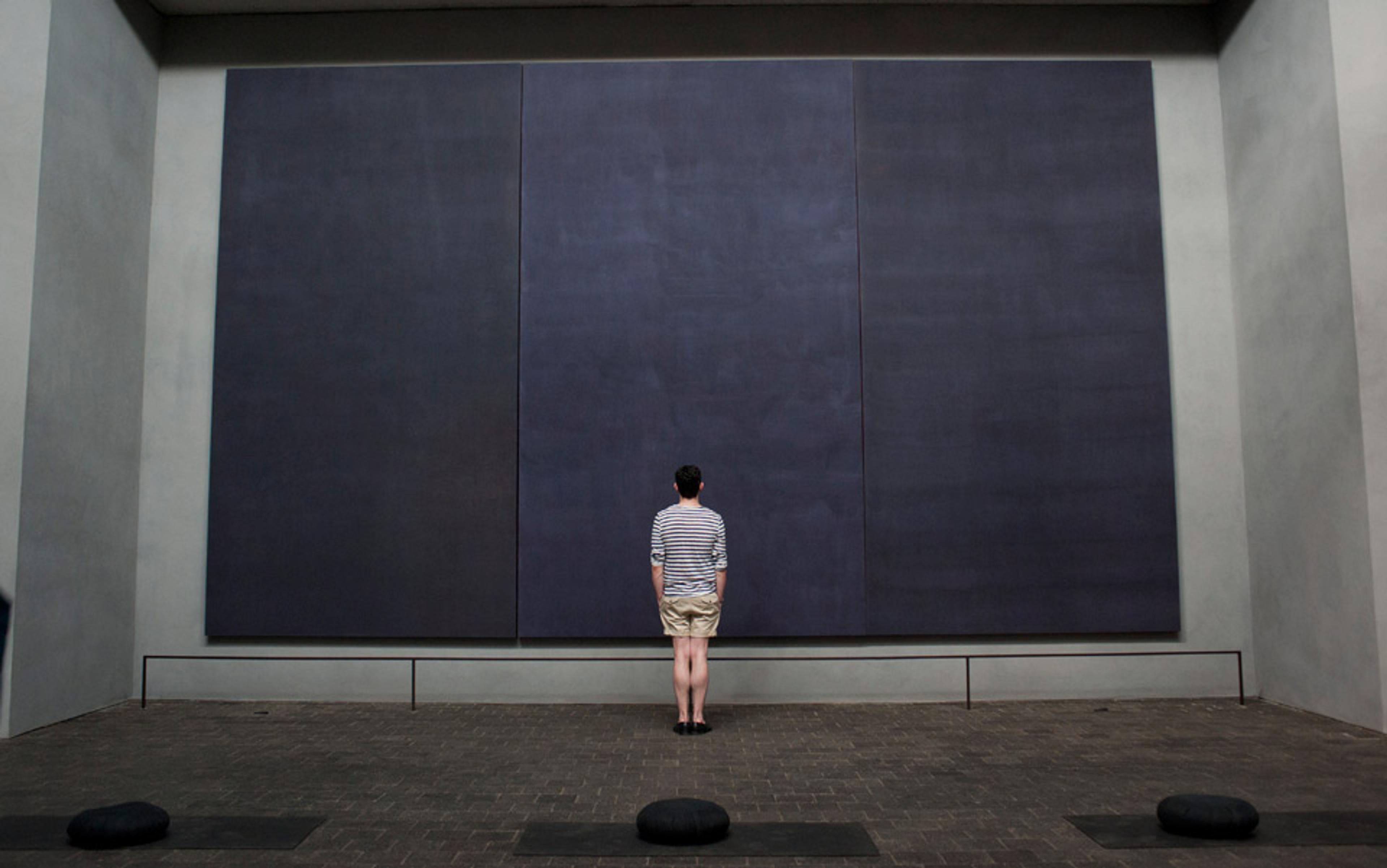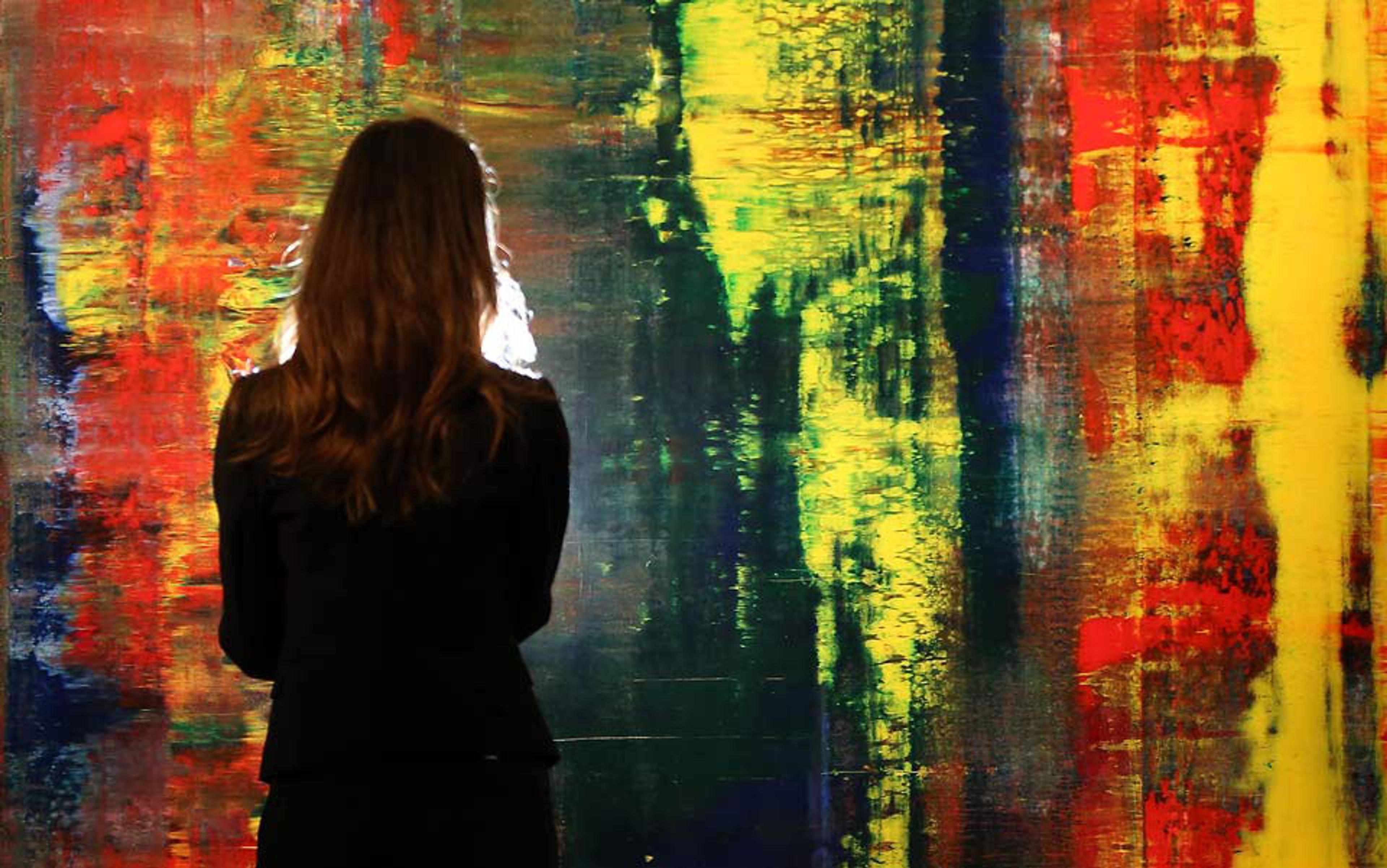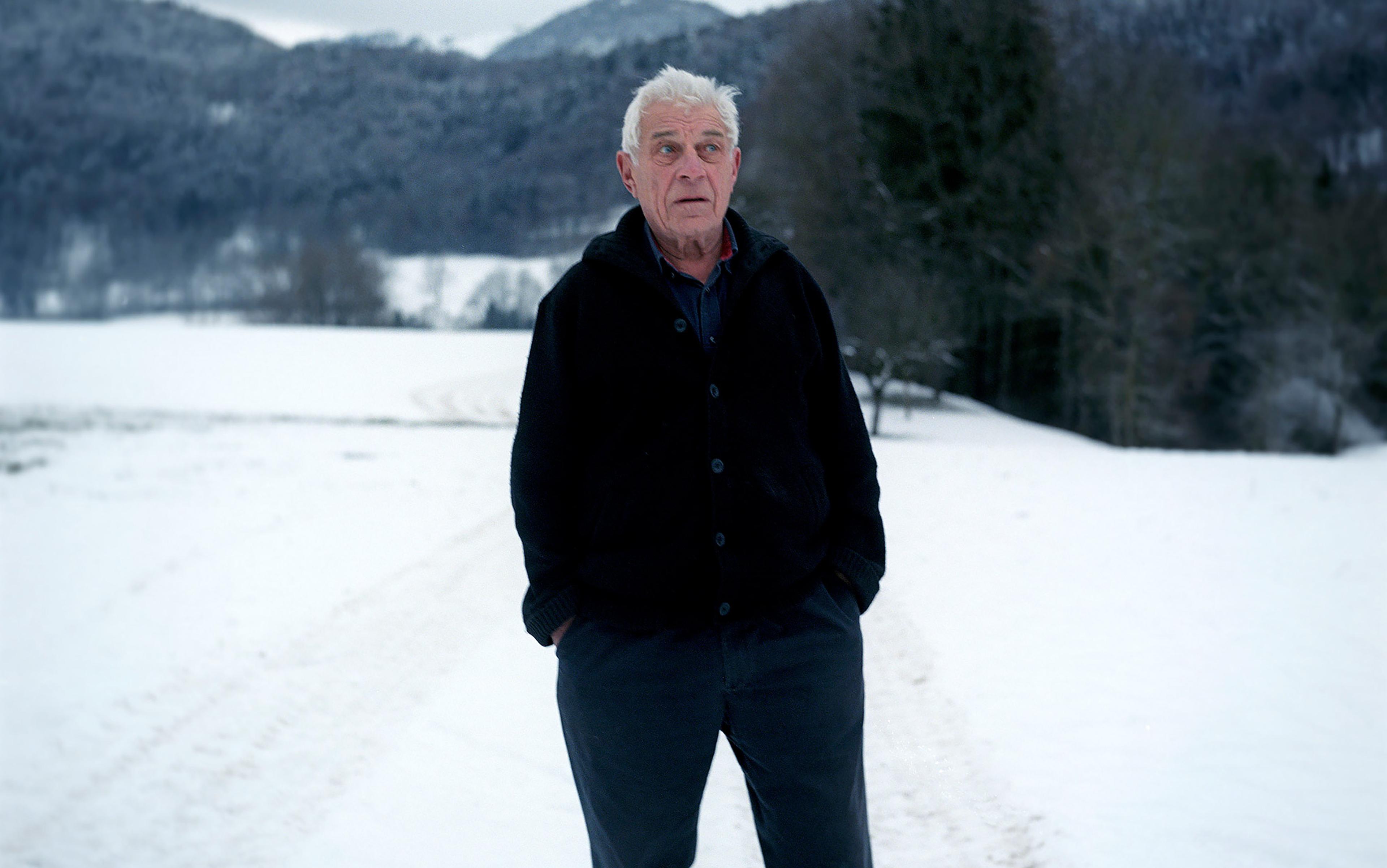On a recent trip to the Rothko Chapel in Houston, Texas, I witnessed a peculiar spectacle. A man who had been sitting cross-legged in front of a painting stood up and began shouting. The sound was a kind of incantation, which shattered the chapel’s silence. Attendants quickly hustled him outside and amid the noise I saw that he was wearing red shoes which appeared to be mismatched.
The man’s head was shaved and he wore a baggy sack of faded overalls. Perhaps it was his odd shoes or the way he nervously fingered his gold earrings – he had several – that made me follow him. When I approached him outside, in the glare of the Texan sun, he told me he’d shouted: ‘We are homeless, homeless.’ He said the words were lyrics from Paul Simon’s Graceland (1986), and that having attended the infamous album tour amid anti-apartheid protests in 1987, he had never forgotten them.
The man, Timothy, had a shaggy-dog story about riding a freight train to Texas from Chicago, which sounded like the blurb of a Jack Kerouac novel. I soon learned that Timothy had been in and out of the mental health system and that he’d worked intermittently as a window-cleaner. He had never known his father. His mother was ‘somewhere in Ohio’. What struck me was his wide-ranging knowledge of popular culture and the ability to combine it with references to art. He spoke in quick-fire bursts and said that listening to John Coltrane’s jazz album Blue Train (1957) was like ‘hearing prickly bits of Yves Klein’ and that Jay-Z’s hip-hop song ‘Picasso Baby’ was so bad it would make ‘Beuys’ dead hare come back to life and start shitting in people’s ears’. Eugène Atget’s Paris photographs, he said, were like watching a ‘white arrow split the air of Brian Eno’. I pressed him about being drawn to Graceland and he simply said: ‘It’s about me.’
After this encounter, I went back to the album, which I’d always associated with Chevy Chase (who appears in the music video ‘You Can Call Me Al’) and with taking road trips with my uncle when Graceland was his only cassette. I realised I’d never really listened to it.
I first encountered Simon’s solo work while watching late-night TV in the 1990s. The video was ‘The Obvious Child’ from the album The Rhythm of the Saints (1990), which featured Simon strumming a black Yamaha in the ornately dilapidated Pelourinho Square in Salvador de Bahia in Brazil. Surrounded by the Afro-Brazilian collective Grupo Cultural Olodum, whose melancholy drum rhythms seemed to hint at the social prophylaxis and economic hardship of the city’s working-class residents, the song was an addendum to the mix of sheer joy and political antipathy that characterise Graceland.
Simon pursued an euphonic sea change with Graceland after hearing a bootleg cassette tape by the South African group the Boyoyo Boys, which featured township-jive or Mbaqanga, a style that fused the cyclic structure of rural Zulu with jazz. Working with a large group of African musicians, including Tau Ea Matsekha, General MD Shirinda and the Gaza Sisters, the Boyoyo Boys and Ladysmith Black Mambazo, Simon pioneered a synchronicity between African music and US pop that became the first ‘world music’ album to break into the mainstream.
From the opening strains of Forere Motloheloa’s accordion on ‘The Boy in the Bubble’, the album creates a pattern of throbbing, danceable percussion. Many of the memorable guitar riffs move between the hard edges of 4/4 Soweto rhythm and the softer syncopations associated with Malawi and Zimbabwe. ‘Diamonds on the Soles of Her Shoes’ and ‘Homeless’ (the track that induced the Rothko Chapel outburst) feature a combination of lyrics in English and Zulu that have a strong emotional charge, as in ‘Homeless’ when a mournful, bird-like scatting pre-empts the refrain, ‘We are homeless, homeless/Moonlight sleeping on a midnight lake.’ In ‘Graceland’, with its bass-line narrative of taking a road trip to the Elvis estate in Memphis, Simon manages in a peculiarly lilting tone to evoke this quasi-mythic mansion at the same as he makes Graceland a repository for the larger narrative of slavery in the South and, further, of South Africa’s promise of freedom.
Graceland is a bold sonic experiment – via an intuitive mix of disparate musical styles with anti-bombastic poetry, it achieved a form of enduring political agitation
In this way, Graceland is indivisible from the politics of the 1980s, when the African National Congress’s decades-long campaign of internal resistance to the Afrikaner-dominated National Party’s policy of white supremacy and strict racial segregation attained critical impetus. In December 1980, the United Nations approved a cultural boycott, urging all states to prevent cultural exchanges with South Africa. In 1985, Bob Dylan, Bruce Springsteen, Peter Gabriel, Lou Reed and Joey Ramone collaborated on the protest song ‘Sun City’ attacking the white-only luxury resort complex in Bophuthatswana, where musicians such as Rod Stewart and Queen had previously commanded large fees to perform. Graceland was thus a highly controversial project. In travelling to South Africa for recording sessions in 1986, Simon attracted the censure of Dali Tambo, the founder of Artists Against Apartheid, and received numerous bomb threats on tour. The following year, Paul Weller and Billy Bragg joined a large protest outside the Royal Albert Hall in London before a Graceland concert and signed a letter demanding that Simon apologise to the UN General Assembly.
Graceland has since come to be seen – particularly in Joe Berlinger’s documentary Under African Skies (2012) – as having helped usher in an end to apartheid, by raising global awareness of South African culture. The appearance of Ladysmith Black Mambazo on the US TV show Saturday Night Live in 1986 and the inclusion of exiled South African musicians Hugh Masekela and Miriam Makeba on the Graceland tour, created a humanising portrait of South Africa’s oppressed classes that connected with a large international audience. Album sales climbed to 14 million. The legacy of Graceland’s song cycle has been to mark the album as a bold sonic experiment that achieved, via an intuitive mix of disparate musical styles with anti-bombastic poetry, a form of enduring political agitation.
I am interested in how this celebratory album was evoked in Timothy by the sedate atmosphere of the Rothko Chapel. The building is octagonally shaped. A soft skylight hovers over 14 black or near-black paintings. There are several moveable benches but people often sit on the floor. I couldn’t get Timothy to describe the one painting that had triggered his outburst. But in the video for ‘You Can Call Me Al’, Simon and Chevy Chase sit in a bare room with rose-coloured walls. The chapel’s walls are also rose-coloured, and there’s a line in the song that resonates with a space dedicated to private prayer: ‘He sees angels in the architecture/Spinning in infinity/He says Amen! And Hallelujah!’
In the music video for ‘Homeless’, meanwhile, houses are bulldozed amid the general chaos of life under apartheid. When the art collectors Dominique and John de Menil commissioned the paintings from Mark Rothko in 1964, they envisioned the chapel as a space for dialogue about issues of homelessness and poverty. It opened in February 1971, one year on from Rothko’s death, with Barnett Newman’s sculpture Broken Obelisk installed outside it, dedicated to the recently assassinated Martin Luther King Jr.
Since its opening, the chapel has doubled as a centre for conferences on global issues, drawing academics from all over the world; and in 1986 the chapel’s board established a human rights award with the former US president Jimmy Carter. Nelson Mandela, recently released from jail in South Africa, served as a keynote speaker, and received ‘The Rothko Chapel Award’ in 1991.
It seems that there was something about the chapel’s intended function that precipitated Timothy’s response. The website describes it as a centre that supports ‘human rights, and has become a rallying place for all people concerned with peace, freedom, and social justice throughout the world’. Timothy’s response was personal, triggered by his past. It had the force of emotion more than intellect.
Rothko’s paintings, and their context within the chapel, resonate in ways not dissimilar to Graceland. The chapel allows for contemplation and prayer through painting, where the album embeds notion of inequality, alienation and racism among spritely 1980s synths and loose dance rhythms. Put simply, apartheid is burbling under the surface of Graceland, while in the Rothko Chapel the paintings create a highly personal response, one that, at least in Timothy’s case, resonates with the plight of the disfranchised and the unseen.
the landscape, the nude or the teapot generally require the viewer to see a certain object. Rothko’s abstraction allowed Timothy to hear the subject of representation
Perhaps there is something inherently musical in the experience of abstract art. Wassily Kandinsky’s abstractions were the result of a lifelong preoccupation with the relationship between sound and colour. He discovered his synaesthesia at a performance of Richard Wagner’s opera Lohengrin in Moscow: ‘I saw all my colours in spirit, before my eyes. Wild, almost crazy lines were sketched in front of me.’ Synaesthesia unites the senses in such a way that the stimulation of one acts like a powerful domino for the others, involuntarily collapsing them together.
Piet Mondrian’s work also encapsulated the rhythm, energy and structure of jazz, introduced to him by US soldiers after the First World War. How do the concerns of these artists translate to the viewer? For Timothy, the near-black void of Rothko’s paintings conjured up the tonal space and rhythm of Graceland. While representational art – of the landscape, the nude or the teapot – generally requires the viewer to see a certain object, Rothko’s abstraction allowed Timothy to hear the subject of representation.
The chapel also induced a certain intimacy of the emotions with respect to the music of memory. The philosopher Kendall Walton, in a scholarly article on the ‘physicality of music’, suggests that such emotional intimacy with respect to music arises when the listener imagines a certain experience of the emotion, and his imagination then becomes the experience of the emotion. He describes this as automatic mimicry. In this case, Rothko’s paintings assumed the character of a ‘silent music’ that was given a voice through Timothy.
After Rothko’s suicide in 1970, Morton Feldman composed the piece ‘Rothko Chapel’ following his experience of the 14 canvases. The result couldn’t be further from Graceland. Rather than the exuberance of township-jive, the piece is minimal and sombre, combining a lonely melody on the viola with celesta chimes and the sustained, block chords of a choir. The sound is like the echo from a funereal abyss.
In 1947, Rothko said:
I think of my pictures as dramas… They have been created from the need for a group of actors who are able to move dramatically without embarrassment and execute gestures without shame. Neither the action nor the actors can be anticipated, or described in advance. They begin as an unknown adventure in an unknown space.
Elsewhere, Rothko stated that ‘a picture lives by companionship’.
Being in the chapel is to be in the 20th century, caught in a tug-of-war between Rothko’s Beckettian lament and a rosy 1980s lightness. After leaving Timothy outside in the sun, I returned to sit and walk the space for hours. The weight of its ambition and purpose did not inspire transcendence but the longing for transcendence and, in the failure of being wholly drawn into the void, I felt a kind of intuitive empathy, for Timothy – what would become of him? – and for Rothko, who never lived to see the chapel. In light of Timothy’s observation, my view of Rothko’s paintings will never again be limited to Modernist despair. I will always hear Graceland.






